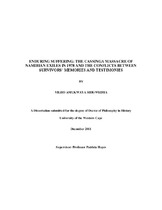| dc.description.abstract | During the peak of apartheid, the South African Defence Force (SADF) killed close to a thousand Namibian exiles at Cassinga in southern Angola. This happened on May 4 1978. In recent years, Namibia commemorates this day, nationwide, in remembrance of those killed and disappeared following the Cassinga attack. During each Cassinga anniversary, survivors are modelled into 'living testimonies' of the Cassinga massacre. Customarily, at every occasion marking this event, a survivor is delegated to unpack, on behalf of other survivors, 'memories of Cassinga' so that the inexperienced audience understands what happened on that day. Besides survivors' testimonies, edited video footage showing, among others, wrecks in the camp, wounded victims laying in hospital beds, an open mass grave with dead bodies, SADF paratroopers purportedly marching in Cassinga is also screened for the audience to witness agony of that day. Interestingly, the way such presentations are constructed draw challenging questions. For example, how can the visual and oral presentations of the Cassinga violence epitomize actual memories of the Cassinga massacre? How is it possible that such presentations can generate a sense of remembrance against forgetfulness of those who did not experience that traumatic event? When I interviewed a number of survivors (2007 - 2010), they saw no analogy between testimony (visual or oral) and memory. They argued that memory unlike testimony is personal (solid, inexplicable and indescribable). Memory is a true picture of experiencing the Cassinga massacre and enduring pain and suffering over the years. In considering survivors' challenge to the visually and orally obscured realities of the Cassinga massacre, this study will use a more lateral and alternative approach. This is a method of attempting to interrogate, among other issues of this study, the understanding of Cassinga beyond the inexperienced economies of this event production. The study also explores the different agencies, mainly political, that fuel and exacerbate the victims' unending pathos. These invasive miseries are anchored, according to survivors, in the disrupted expectations; or forsaken human dignity of survivors and families of the missing victims, especially following Namibia's independence in 1990. | en_US |

